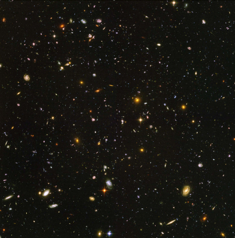
How often are stars born?
To answer this question we need to talk about the number of stars born each year or, more accurately, the amount of material (gas & dust) that is converted into stars per year. This is expressed in solar masses per year (one solar mass is equal to the mass of our Sun = 2x1027 kg). This quantity is called the "star formation rate". In our Galaxy the current star formation rate is about 3 solar masses per year (i.e. interstellar gas and dust corresponding to about 3 times the mass of the Sun goes into stars each year). However, all this mass doesn't necessarily go into 1 star. Some stars are more massive than 3 solar masses and some are less massive. However, stars like our Sun (1 solar mass) are quite common and so we can approximate the star formation rate to be about 3 stars (like our Sun) per year in our Galaxy.
Furthermore, we estimate that there are about 50 billion galaxies in the entire observable Universe. Now all galaxies are different - our own is a typical spiral galaxy, but there are large and small spirals, giant and dwarf ellipticals, irregulars, etc. However, if we once again assume that our own Milky Way Galaxy represents an average type of galaxy, we can calculate that there are roughly 150 billion stars born per year in the entire Universe. This corresponds to about 400 million stars born per day or 4800 stars per second! If we turn this around, this mean that throughout the entire Universe, a star is born every 0.0002 seconds (i.e. every 2, 10,000th's of a second)!!


(Left) VLT image of a spiral galaxy. The blue stars indicate regions containing very young, massive stars. (Right) Hubble Ultra Deep Field of a small region of the sky. Every “dot” in this image is an entire galaxy!

